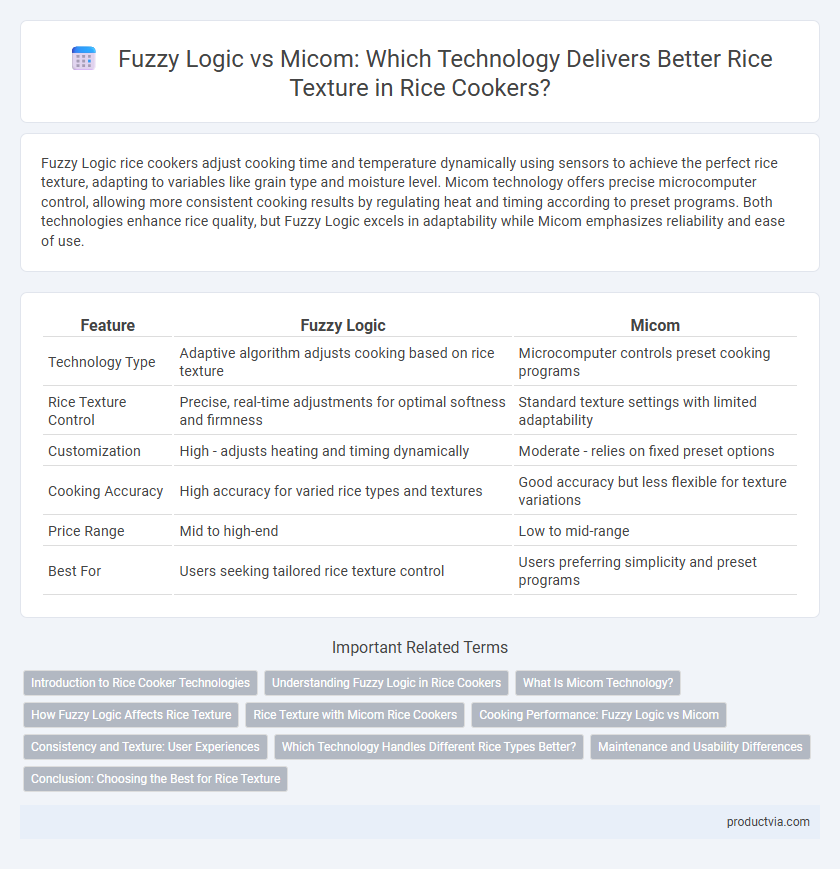Fuzzy Logic rice cookers adjust cooking time and temperature dynamically using sensors to achieve the perfect rice texture, adapting to variables like grain type and moisture level. Micom technology offers precise microcomputer control, allowing more consistent cooking results by regulating heat and timing according to preset programs. Both technologies enhance rice quality, but Fuzzy Logic excels in adaptability while Micom emphasizes reliability and ease of use.
Table of Comparison
| Feature | Fuzzy Logic | Micom |
|---|---|---|
| Technology Type | Adaptive algorithm adjusts cooking based on rice texture | Microcomputer controls preset cooking programs |
| Rice Texture Control | Precise, real-time adjustments for optimal softness and firmness | Standard texture settings with limited adaptability |
| Customization | High - adjusts heating and timing dynamically | Moderate - relies on fixed preset options |
| Cooking Accuracy | High accuracy for varied rice types and textures | Good accuracy but less flexible for texture variations |
| Price Range | Mid to high-end | Low to mid-range |
| Best For | Users seeking tailored rice texture control | Users preferring simplicity and preset programs |
Introduction to Rice Cooker Technologies
Fuzzy Logic technology in rice cookers enables precise adjustments by sensing temperature and humidity, producing optimal rice texture through adaptive cooking cycles. Micom (microcomputer) technology uses a microprocessor to control heating elements, allowing for programmable settings and consistent results based on preset algorithms. Both technologies enhance rice texture quality, with Fuzzy Logic offering dynamic, real-time corrections and Micom providing reliable, user-friendly automation.
Understanding Fuzzy Logic in Rice Cookers
Fuzzy Logic in rice cookers intelligently adjusts cooking time and temperature by analyzing sensor data to achieve the desired rice texture, offering a more precise and adaptable cooking process than traditional Micom technology. Unlike Micom's basic microcomputer control that operates on pre-set programs, Fuzzy Logic mimics human decision-making for better consistency and texture customization. This technology ensures optimal moisture retention and uniform cooking, enhancing the overall quality of rice.
What Is Micom Technology?
Micom technology in rice cookers utilizes a microcomputer chip to precisely control cooking time and temperature, resulting in perfectly cooked rice with consistent texture. Unlike fuzzy logic, which adapts cooking patterns based on sensor input, Micom technology relies on pre-set programs for specific rice varieties and textures. This ensures a more accurate and efficient cooking process tailored to the user's selected rice type and preferred softness.
How Fuzzy Logic Affects Rice Texture
Fuzzy logic technology in rice cookers continuously monitors temperature and adjusts cooking time with precision, resulting in consistently optimal rice texture that adapts to different rice types and moisture levels. Unlike conventional Micom (microcomputer) systems that rely on preset programs, fuzzy logic mimics human decision-making, offering fine-tuned control over the cooking process for fluffier, well-cooked rice grains. This intelligent adaptation reduces undercooked or overcooked rice, enhancing overall texture and taste.
Rice Texture with Micom Rice Cookers
Micom rice cookers use microcomputer technology to precisely control cooking temperature and time, adapting to different rice types for optimal texture. This intelligent control ensures consistent, fluffy rice with proper moisture balance, enhancing taste and texture more accurately than basic fuzzy logic models. Users benefit from customizable cooking modes that adjust heating patterns to achieve ideal rice softness or firmness.
Cooking Performance: Fuzzy Logic vs Micom
Fuzzy Logic rice cookers use advanced sensors and algorithms to adjust heat and cooking time dynamically, ensuring precise control over rice texture for consistently fluffy or sticky results. Micom (Micro Computer) models offer programmable settings and microprocessor-controlled timing but may lack the adaptive real-time adjustments found in Fuzzy Logic systems. Fuzzy Logic outperforms Micom in cooking performance by delivering better texture customization and accommodating variations in rice type and moisture.
Consistency and Texture: User Experiences
Fuzzy Logic rice cookers adapt cooking time and temperature dynamically, achieving softer and more consistent rice textures by fine-tuning heat distribution. Micom rice cookers rely on microcomputer controls that set precise cooking parameters but may offer less adaptability to varying rice types, sometimes resulting in slightly inconsistent texture. User experiences highlight Fuzzy Logic models for superior texture uniformity, while Micom units are praised for reliability but occasionally produce less predictable results.
Which Technology Handles Different Rice Types Better?
Fuzzy logic rice cookers excel in adapting cooking times and temperatures dynamically to suit various rice types, ensuring optimal texture through continuous adjustments. Micom (microcomputer) technology allows precise control using pre-programmed settings tailored for specific rice varieties but may lack the nuanced adaptability of fuzzy logic systems. When handling diverse rice types, fuzzy logic provides superior flexibility and consistency in achieving ideal texture compared to the more rigid Micom controls.
Maintenance and Usability Differences
Fuzzy Logic rice cookers offer advanced sensor technology that adjusts cooking parameters automatically, requiring less frequent calibration and simpler maintenance compared to Micom models, which rely on microcomputer control and may need occasional manual adjustments. Usability in Fuzzy Logic cookers is enhanced by their intuitive interface and adaptive cooking cycles, while Micom cookers provide consistent performance but often demand more user input for texture customization. These differences impact long-term convenience, with Fuzzy Logic systems generally favored for ease of use and minimal upkeep in achieving optimal rice texture.
Conclusion: Choosing the Best for Rice Texture
Fuzzy Logic rice cookers offer advanced microprocessor control that adjusts cooking temperature and time dynamically, resulting in precise rice texture tailored to different types of rice. Micom rice cookers use a fixed program with microcomputer technology to moderate cooking but lack the adaptive refinement of fuzzy logic systems. For optimal rice texture, fuzzy logic models are superior due to their ability to detect and respond to multiple variables during the cooking process, ensuring consistently perfect results.
Fuzzy Logic vs Micom for rice texture Infographic

 productvia.com
productvia.com